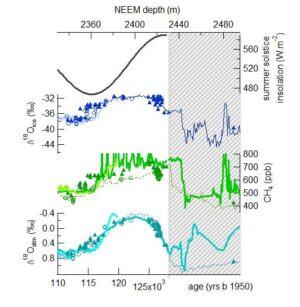The last interglacial period (LIG, ~129-116 thousand years ago) provides the most recent case study for multi-millennial polar warming above pre-industrial level and a respective response of the Greenland and Antarctic ice sheets to this warming, as well as a test bed for climate and ice sheet models. Past changes in Greenland ice sheet thickness and surface temperature during this period were recently derived from the NEEM ice core records, North-West Greenland. The NEEM paradox has emerged from an estimated large local warming above pre-industrial level (7.5 ± 1.8°C at the deposition site 126 ka ago without correction for any overall ice sheet altitude changes between the LIG and pre-industrial) based on water isotopes, together with limited local ice thinning, suggesting more resilience of the real Greenland ice sheet than shown in some ice sheet models. Here, we provide an independent assessment of the average LIG Greenland surface warming using ice core air isotopic composition (d15N) and relationships between accumulation rate and temperature. The LIG surface temperature at the upstream NEEM deposition site without ice sheet altitude correction is estimated to be warmer by +8.5±2.5°C compared to the pre-industrial period. This temperature estimate is consistent with the 7.5±1.8°C warming initially determined from NEEM water isotopes but on the upper end of the pre-industrial to LIG temperature difference of +5.2±2.3°C obtained at the NorthGRIP site by the same method. Climate simulations performed with present day ice sheet topography lead in general to a warming smaller than reconstructed, but sensitivity tests show that larger amplitudes (up to 5°C) are produced in response to prescribed changes in sea ice extent and ice sheet topography.
Link: http://www.clim-past.net/12/1933/2016/



